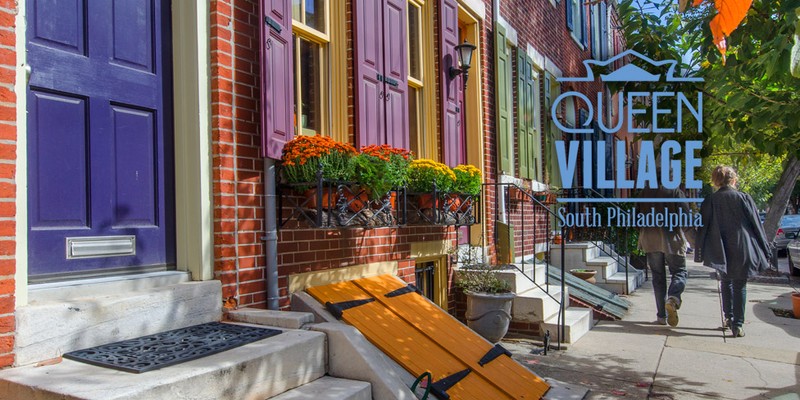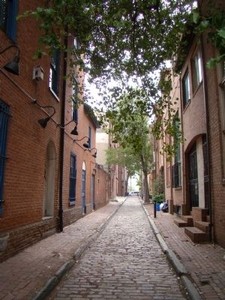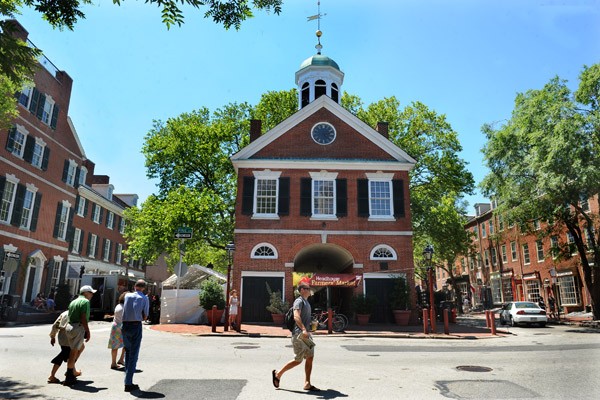Queen Village, the New Market, and Head House
Introduction
Text-to-speech Audio
Images
Queen Village, Philadelphia (image from Visit Philadelphia)

Naudain Street at 2nd Street, Queen Village (image from Historic Marker Database)

Headhouse Farmer's Market at the New Market/Head House historic site (image from Visit Philadelphia)

Backstory and Context
Text-to-speech Audio
Swedish settlers did little to alter the natural environment surrounding their homes and small farms, leaving meadows and riparian forests of beech, elm, and buttonwood intact and filled with elk, deer, beaver, and other game. New Sweden enjoyed a highly profitable fur trade as a result. The area which would become Queen Village was owned by the Sven family; their one and a half story log house stood at the northwest corner of present-day Beck and Swanson Streets, encircled by a large garden and fruit trees and with its own dock for small boats. The Sven home, dating to 1677, was used as a place of worship (The house was destroyed during the American Revolution, when the British Army used its logs as fuel.) Meanwhile, in Europe, Sweden suffered a loss of power in the mid-1600s. The Dutch claimed control of New Sweden, then ceded it to England, whose King Charles II granted present-day Pennsylvania to William Penn.
Penn established the city of Philadelphia in 1682, at the time just north of the Swedish village at Weccacoe (Queen Village), an area which Penn renamed Southwark, after a London neighborhood along the Thames River. As a Quaker, Penn ensured religious tolerance, and the Swedes, who had established six congregations by that time, decided to construct their first permanent church, Gloria Dei, in 1698 on the site of an older log church. Early Southwark developed as a riverside commercial area, becoming home to sailors, dock workers, carpenters and shipbuilders, rope and sail makers, and a variety of craftsmen. Though Southwark would not officially be considered part of the city of Philadelphia until 1854 (under the Act of Consolidation), the two converged upon each other by the early 18th century, and the Southwark District rapidly changed from a village to a busy, urban neighborhood consisting of two townships known by their original American Indian names, Moyamensing (pigeon droppings) and Passyunk (in the valley). Some of the mid-18th century Southwark homes survive to this day, including the Nathanial Irish House (704 South Front Street), the George Mifflin House (100 block of Pemberton Street), and the brick row houses on the 100 block of Beck Street. Philadelphia outlawed wood frame buildings within city limits in 1796 due to the risk of fire, but in Southwark, plank homes were already prevalent, and some survive still along the blocks of 800 South Hancock, 200 Christian, and 100 League Streets.
One of the oldest colonial markets in America, now a National Historic Landmark, the covered and colonnaded New Market was built in 1745 to serve the Society Hill and Southwark neighborhoods. It was also referred to as "the shambles" (an old English term for a butcher shop). Market days were Tuesday and Friday, and goods available included various meats (fish, turtle, poultry, veal, mutton, sausage, and even raccoon, possum, bear bacon, and bears' feet), meat and fruit pies, eggs, and fresh fruits and vegetables. Adjacent to the New Market were two fire stations known as the Head Houses (one of which was built in 1805 and remains standing, the other of which was of older construction and was demolished circa 1860). Three volunteer fire companies, The Fellowship, The Hope, and the Southwark Hose Companies operated out of these two houses, and private citizens donated money for the 1805 Head House's clock and alarm bell, which also announced the opening of the market on Tuesday and Friday mornings.
During the 1830s and 1840s, mass immigration to Philadelphia and Southwark, particularly from Ireland, caused competition for low wage jobs, overcrowding, and an uprising of "Nativist" anti-Catholic sentiment. A three-day riot occurred at Queen and 2nd Streets, at St. Philip Neri Roman Catholic Church, causing deaths, injuries, and the near-destruction of the church. Only the intervention of the militia and the Wiccaco Firehouse prevented further destruction. The Civil War kept the area bustling with tens of thousands of Union Soldiers passing through volunteer-driven Welcome Centers in Southwark, which came to be called South Philadelphia. After the war, a new influx of Eastern European immigrants came through the Washington Avenue emigration depot, built by the Pennsylvania Railroad. African Americans also arrived from the Southern states, many settling along South Street. The 4th Street commercial corridor (Fabric Row today) became a Russian Jewish neighborhood, and the waterfront became home to Polish dockworkers. Due to overcrowding, living conditions were not only unsanitary, but also unsafe, particularly from social unrest, crime, and disease, complicated by industrial pollution. At the beginning of the 20th century, the philanthropic Octavia Hill Association (which still manages properties in Queen Village) provided affordable housing to the poor, but the neighborhood's reputation as dangerous continued as the area declined. The local population shrank after 1950, and urban renewal projects failed to help the neighborhood thrive in the 1960s. Over 300 historic 18th century homes were demolished to make way for Interstate 95.
In the hopes of renewing interest in Philadelphia's oldest suburb, local real estate agents renamed the area Queen Village in honor of Swedish Queen Christina. The derelict South Street commercial district attracted new businesses and artists in the 1980s. Encouraged by the restoration of the Society Hill neighborhood, historic buildings were restored and new businesses and residents moved in. Now, it is considered an affluent neighborhood and part of downtown Philadelphia.
Historic Marker Inscriptions:
QUEEN VILLAGE. Philadelphia’s first neighborhood. Cross the
street to the south side of Lombard and you’ve entered Queen Village, the
oldest neighborhood in Philadelphia and one of the oldest “urban villages” in
the country. This community is known for its large stock of 18th- and
l9th-century buildings, many of them unchanged from colonial times. Some
streets look very much like they did 200 years ago.
Queen Village was settled by Swedes in the 1600s and named Wicaco, the Lenape
tribe’s word for “peaceful place.” Its name has changed twice since then.
William Penn named it Southwark after a neighborhood in London. It was renamed
Queen Village in the 1970s to honor the role of Sweden’s Queen Christina in
promoting the original settlement.
Early residents included ship builders, rope and sail makers, sailors, dock
workers, carpenters and craftsmen. Today Queen Village is home to a vibrant mix
of people of all backgrounds and economic levels. Its thriving businesses and
residential areas make it an exciting community in which to live and work.
Queen Village has several landmarks of note:
Sparks’ Shot Tower. Located at Front and Carpenter Streets, this was the
first shot tower in the United States. Lead shot was made here for the U.S.
Army during the War of 1812.
South Street. A place where Philadelphians have
shopped and been entertained for over 200 years. The nation’s first permanent
theater, Southwark Theater, was located at South and Leithgow Streets. George
Washington attended plays there.
Gloria Dei (Old Swedes’) Church. Located at Swanson and Christian
Streets, this is the oldest church in Pennsylvania. Built in 1700 as a Lutheran
church by descendants of the early Swedish settlers, it became part of the
Episcopal Church in 1845. Betsy Ross, credited with sewing the first American
flag, was married here.
2nd Street. This is the home base of the Mummers, those New Year’s
celebrants known for their colorful costumes and marching string bands. At the
southwest corner of 2nd Street and Washington Avenue, you’ll find the Mummers
Museum, a repository of costumes and Mummer history.
4th Street Fabric Row. Thought to be the country’s oldest fabric
district, these retail stores continue south on 4th Street from Bainbridge
Street.
Queen Village extends south from Lombard Street to Washington Avenue, and
from the Delaware River west to 6th Street.
(Sidebar) Over the years, Queen Village has been home to many famous
people. Here are a few names you may recognize.
• Surveyors of the “Mason-Dixon” line, Charles Mason and Jeremiah Dixon
• Movie actor & comedian, Larry Fine (a.k.a. ‘Larry’ of the Three Stooges)
• The artist. Man Ray (born Emmanuel Rudnitzky)
• Rock ’n Roll singer & musician, Chubby Checker (born Ernest Evans)
• Basketball player, Maurice “Mo” Cheeks of the Philadelphia 76ers
THE NEW MARKET AND HEAD HOUSE. This graceful structure, a National Historic Landmark, is one of the oldest colonial markets in America. It is adjacent to what is probably the nation’s oldest volunteer firehouse. Built in 1745, the covered colonnaded marketplace was called “the shambles,” an old English word meaning “butcher shop or meat stalls.” At the north end, a three-story firehouse known as “the Head House” was built in 1805.
The New Market. In an era before refrigeration and supermarkets, open air markets provided vendors a place to sell fresh foods. In colonial Philadelphia, the first public market was located at the east end of High (now Market) Street. In 1745, a “New Market” was started here at Second Street (stretching from Pine to South Street) for the convenience of the growing population in Society Hill and Southwark (now Queen Village). / On market days (Tuesdays and Fridays) shoppers purchased fish, turtles, fresh vegetables and fruits, eggs, turkeys, chickens, veal, mutton, sausage and prepared foods, such as meat and apple pies. Occasionally raccoon, possum, bear-bacon or bear’s feet were available. The farmers’ wagons arrived the night before, pulling up to stalls along the shambles. Customers walked inside the covered center arcade to make their purchases. On dark days, oil lamps at the ceiling were lit. Vendors continued to sell their goods here into the 20th century.
The Head House. In 1736 Benjamin Franklin began a campaign
of fire prevention, urging the establishment of community volunteer fire
companies equipped with mannually operated pumping engines and large bells to
signal fires. / In 1805 the Head House at Pine Street was built, pairing it
to an earlier Head House located at the South Street end of the market shambles
(demolished about 1860). These two “head houses” contained fire engines and
apparatus for the members of three volunteer fire companies: The Fellowship,
The Hope and The Southwark Hose Companies. The second floor interiors served as
meeting rooms for the firefighters. / Private citizens raised funds for the clock in the gables
and the alarm bell in the cupola which rang for fires and announced the opening
of market days. / This property, owned by the City of Philadelphia, was saved
from demolition and repaired in 1962-63, but was again in need of preservation
thirty years later A grassroots citizens’ group, The Head House Conservancy,
accomplished this in the 1990s.
